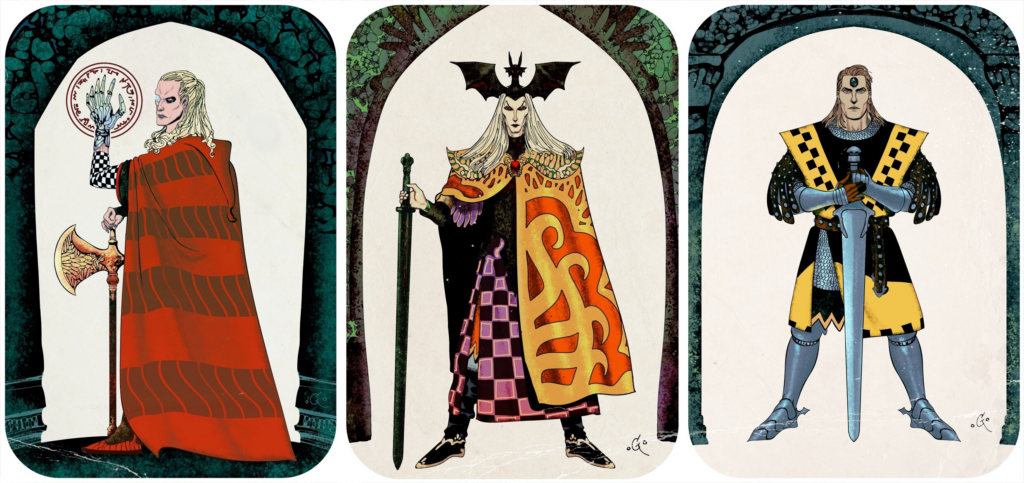
The Real, the Symbolic, and the Imaginary
The Eternal Champion, particularly Elric of Melniboné, revolves around three orders:
- The Real: The unknowable, traumatic, pre-symbolic realm we encounter as infants. It’s marked by a lack and a constant desire to return to a state of wholeness. The ever-present chaos beyond language and symbolization. This is embodied by the Multiverse, the endless cycle of the worlds, and the raw, destructive power that Elric wields through Stormbringer. It represents the primal urges and desires that constantly threaten to disrupt the established order.
- The Symbolic: The structures of Law that bring order and meaning to the world. This is represented by the Cosmic Balance, the empires and civilizations that strive for stability (like Law’s Jireikan), and the duty of the Eternal Champion to maintain the equilibrium. The order of language and social structures that shape our identities and understanding of the world.
- The Imaginary: The realm of perception and fantasy where the ego forms through mirroring the “other.” The realm of perception, illusion, and fantasy. This is where Elric’s own self-image as a brooding anti-hero resides, caught between his duty and his chaotic nature. It’s also evident in the fantastical landscapes and creatures Elric encounters on his journeys.
Elric’s Lack and the Desire for the Other
Lacan suggests that humans are forever driven by a sense of lack and the desire for the Other, a wholeness we can never achieve. Elric embodies the Lacanian concept of lack. He is haunted by the impossibility of achieving a unified self.
- Stormbringer: His cursed sword, Stormbringer, represents the Real, the insatiable desire that constantly disrupts his attempts at stability. It craves souls, mirroring Elric’s own internal void.
- The Cycle and The Balance: The Cosmic Balance and the Longhouse of the Cycle represent the Symbolic order, the forces that try to impose order on the chaos. Elric, as the pawn caught between Law and Chaos, embodies the struggle between these forces.
- The Lack: Elric’s inherent connection to Chaos creates an absence within him, a yearning for order he can never fully embrace. Stormbringer’s corrupting influence and his own melancholic nature fuel this lack. Lacan posits that human desire is inherently lacking, a constant striving for something unattainable. Elric’s desire could be interpreted in a few ways: The Desire for Balance: Elric, despite his chaotic nature and the pull of Stormbringer, might yearn for a restored balance in the Multiverse. This aligns with the Champion’s duty. The Desire for Death: Elric’s weariness and the burden of his role could lead to a death drive, a desire for the oblivion that true balance might bring. The Desire for Redemption: Elric’s actions often cause destruction, yet he continues his fight. This could be seen as a desire for redemption, to break free from the cycle and achieve some form of peace. The Desire for the Other: Elric’s conflicted relationship with Mabyn represents the desire for the Other. She embodies the Law and the balance he craves, yet her connection to it also restricts him. This creates a tension that fuels his actions.
The Fragmented Self and the Other
Elric’s fractured soul can be understood through the Lacanian concept of the fragmented self.
- Mabyn: Mabyn, his love, represents the Imaginary, the idealized image Elric chases to achieve wholeness. However, their love is tainted, mirroring the impossibility of ever truly fulfilling his desires.
- The Dragon Lords and The Runelords: These opposing factions represent the Symbolic order’s extremes. Elric, caught between them, can never fully identify with either, highlighting the fragmented nature of his existence.
The Gaze and the Split Subject
- Elric’s existence as the Eternal Champion across multiple realities reflects the Lacanian concept of the split subject. The gaze of the Other, in this case, the Multiverse and its demands, forces Elric into a fractured identity. He is both the champion and the destroyer, the pawn and the king. This fractured self reflects the struggle between his inherent chaotic nature and the imposed order of the Champion’s role.
- The Gaze of the Other and the Split Subject
- Elric’s interactions with others highlight Lacanian concepts:
- The Gaze of the Other: Elric grapples with the expectations placed on him as the Champion. This “gaze” from the Multiverse, Mabyn, and even Stormbringer creates a sense of duty and burden.
- The Split Subject: Elric’s internal conflict between his duty and his chaotic urges reflects the Lacanian concept of the split subject. He is both the champion and the destroyer, the pawn and the king. Stormbringer further embodies this split, representing both his power and his downfall.
The Symbolic Order and its Price
- The duty of the Eternal Champion exemplifies the limitations of the Symbolic Order. While it brings stability, it also confines and restricts. Elric’s internal conflict stems from this imposed order clashing with his chaotic desires. This reflects Lacan’s critique of how the Symbolic Order can limit individual freedom.
Elric’s actions can be seen as a constant negotiation with the Symbolic order.
- The Eternal Champion: The very title signifies a forced role within the Cosmic Balance. Elric is not truly free but compelled to act.
- His Moral Ambiguity: Elric’s choices are often morally ambiguous. He walks the line between Law and Chaos, reflecting the inherent contradictions within the Symbolic order itself.
Conclusion
We are all haunted by a sense of lack, and our attempts to create order and meaning are constantly challenged by the chaotic forces within and the limitations of the symbolic structures that shape us. Elric’s struggle becomes a metaphor for our own search for identity and our place in a universe that is ultimately unknowable. Elric’s struggles become a metaphor for the human condition, his desire a reflection of our inherent lack, and his existence within the Multiverse a representation of the symbolic and imaginary forces that shape our reality.